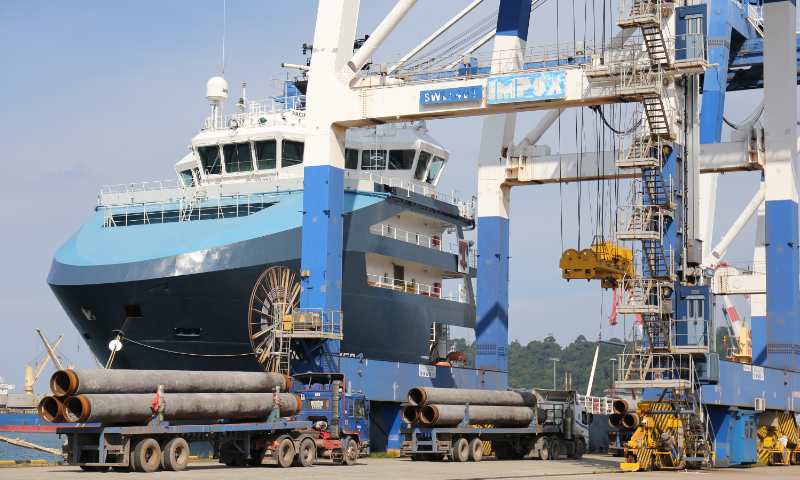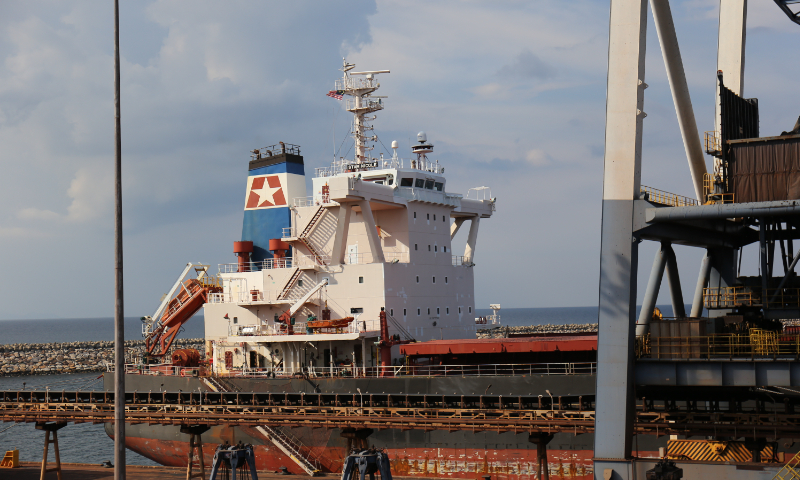This year marks the 10th anniversary of the China-proposed Belt and Road Initiative (BRI), a global cooperation platform that demonstrates China’s vision and provides solutions for the reformation of the global governance system and other challenges. Reflecting on the development of the BRI over the last decade, there has been no shortage of evidence demonstrating its success.
Standing at this monumental juncture, the Global Times is publishing a series of articles to help readers understand the fruitful journey of the BRI in the past 10 years from multiple perspectives, and how the initiative will proceed in the future. This is the sixth installment in the series, examining how the Kuantan Port in Malaysia has risen to be an important trade hub because of BRI.

A view of Kuantan Port in Malaysia in July. Photo: He Zhuoqian/GT
Driving from the Kuantan Port to a nearby steel factory, a vaulted semi-open pipe is stretching along the coast, through which imported Brazilian and Australian iron ore are delivered to the factory’s blast furnace and smelted into industrial metals.
The steel factory is operated by China-invested Alliance Steel, now the largest steel manufacturer in Malaysia in terms of yearly production. It produces over 4 million tons of steel every year, and 70 percent of the products are shipped to overseas markets through the deep-water Kuantan Port, including Europe, the US, other Southeast Asian countries and Africa.
Alliance Steel’s trade volume along with another steel plant owned by Lange Steel at Kuantan accounts for almost 50 percent of the Kuantan Port’s annual container throughput capacity, Ye Jingtao, general manager operation of Kuantan Port, told the Global Times.
The port, sitting at the eastern seaboard of Peninsular Malaysia, now has an annual cargo handling ability of 52 million tons, doubling from the level 10 years ago. It is also the largest port in Malaysia in terms of dry bulk commodity handling capacity of public terminal.
In 2013, China proposed the Belt and Road Initiative (BRI), a global cooperation platform that aims to facilitate all-round connectivity. Facilitated by the initiative, Guangxi Beibu Gulf International Port Group Co started strategic investment in the Kuantan Port in 2013, and bought 40 percent stake in Malaysia’s Kuantan Port Consortium.
“Before [Chinese investment], we were only a small port and could only handle 45,000 to 50,000 ton vessels. We have ventured into building a new [terminal], and now we can handle a bigger vessel up to almost 150,000 tons,” Mazlim Bin Husin, chief commercial officer of the Kuantan Port, told the Global Times. He noted that the capacity expansion is important for manufacturers, taking account of economic viability.
The optimized cost of logistics is of significance for Kuantan, which is located at the East Coast of Peninsular Malaysia – a less developed region compared with the West Coast.
Startling port rise
As this year marks the 10th anniversary of BRI, industry observers pointed out that the port’s startling rise in the past decade offers a glimpse into how the China-proposed initiative has grown from a concept to a key international cooperation platform.
The Kuantan Port now operates an overarching maritime network, leveraging Malaysia’s position as an important gateway for commerce along the 21st Century Maritime Silk Road. Within the Asian region, it now directly connects with multiple ports in China, ASEAN and Japan, according to Ye.
Mazlim Bin Husin said that the BRI has “obviously” enhanced connectivity between China and Malaysia. “We can reach further deeper in China, for example to the western region through sea-railway combined transportation.”
The port has been testing the export of high-value agricultural products from Malaysia to China. In April, durian shipments were sent to Southwest China for the first time through cold-chain sea-railway transportation, from which the tropical fruits were shipped to Qinzhou Port in South China’s Guangxi Zhuang Autonomous Region and then shipped to China’s southwestern region like Chongqing and Chengdu via rail.
“The opening of the new corridor is in line with the switch of basic Chinese manufacturing from eastern coastal areas to the less-developed western regions,” Ye said.
Guangxi Beibu Gulf International Port Group Co is the operator of the Qinzhou Port. The Chinese company has invested in the Malaysia-China Kuantan Industrial Park (MCKIP) in 2013.
Inside the park, a logistic park is being built. With a total investment of $300 million, the logistic park is being jointly developed by China Harbor Engineering Company, Malaysian company IJM and Beibu Gulf Holding Co, and is envisioned to be a comprehensive park that integrates international manufacturing and logistical services.
“Many companies investing in the park are defined as ‘two heads out,’ meaning that their source of raw materials and market for finished products are both located outside Malaysia,” Wan Yu, CEO of Malaysia-China Kuantan International Logistic Park, told the Global Times.
The port has benefited a lot from BRI investments, which fuels its trans-shipment businesses to grow, according to Mazlim. According to the plan, the port’s shipping lines now link up with Middle East, Europe, the Mediterranean and US’ West Coast.
Trade corridors
Industry insiders stressed that a pivotal role BRI has played in global trade is the build-up of “major trade corridors.”
“The BRI mobilizes the resources of every party, which is conducive to shortening logistics route and makes the operations of the networks more convenient. While more cargo is processed through the route, the logistics cost is reduced,” Ye said.
Alliance Steel is one of the first Chinese companies to establish a plant within the industrial park. The investment has helped Malaysia to transform from a steel importing country to an exporting one.
Hu Jiulin, the chief technology officer of Alliance Steel, told the Global Times that his company is constructing more factories within the MCKIP. Once those plants were put into operation, it is expected that the capacity of Alliance Steel could climb to 10 million tons a year.
“It is a mutual promotion effect. On the one hand, the development of Kuantan Port has brought in resources, fostered downstream and upstream industries and eventually led to an industrial cluster. On the other hand, the booming industry provides impetus for the port to further upgrade its capacity,” Ye said.
The port’s development would be further accelerated with the construction of East Coast Rail Link (ECRL) in Malaysia, which links the East Coast and the West Cost of Malaysia, which is forecast to enter service in the coming years.
“This is another important development, and we hope this railway connectivity to propel development along the railroad, and contribute a lot of cargo demand to Kuantan Port,” Mazlim said.
In May, construction of Kota Bharu railway station, the ECRL’s first station, which sits near the Malaysian border with Thailand, commenced. The first phase of the rail section linking the border town of Kota Bharu with the capital of Kuala Lumpur is expected to go into operation in December 2026.




